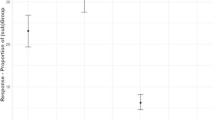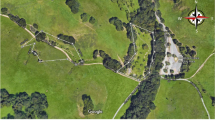Abstract
Under predation threat, many species produce cues that can serve as crucial sources of information for social companions. For instance, chemical cues released when experiencing a disturbing event (i.e. ‘disturbance cues’), such as a predator chase, can lead to antipredator avoidance and increased survival for nearby individuals. These chemicals also have potential to be produced as a voluntary signal for communicating threat to others. We found evidence for this hypothesis by manipulating the shoal familiarity of guppies from populations differing in background predation risk and then presenting their disturbance cues to unfamiliar conspecifics from the same populations. Receivers from low-risk sites increased shoal cohesion and decreased area use regardless of whether the disturbance cues were produced in donor groups where members were familiar or unfamiliar with each other. However, receivers from high-risk sites showed strong antipredator reactions towards disturbance chemicals produced in familiar groups and no response towards those produced in unfamiliar groups, suggesting that donors from high-risk sites may alter the quality or quantity of their disturbance cues to influence familiar individuals to enact predator defences. Because high-risk environments strengthen guppy social networks, these environments may facilitate reliance on chemical disturbance signalling to coordinate group defences with familiar individuals.

Similar content being viewed by others
Data availability
Data are provided as electronic supplementary material.
References
Atton N, Galef BJ, Hoppitt W, Webster MM, Laland KN (2014) Familiarity affects social network structure and discovery of prey patch locations in foraging stickleback shoals. Proc R Soc B Biol Sci 281:20140579
Bairos-Novak KB, Crane AL, Chivers DP, Ferarri MCO (in review) Forget the audience: tadpoles release similar disturbance cues regardless of kinship or familiarity of nearby conspecifics.
Bairos-Novak KR, Mitchell MD, Crane AL, Chivers DP, Ferrari MC (2017) Trust thy neighbour in times of trouble: background risk alters how tadpoles release and respond to disturbance cues. Proc R Soc B Biol Sci 284:20171465
Bairos-Novak KR, Crane AL, Chivers DP, Ferrari MC (2018) Better the devil you know? How familiarity and kinship affect prey responses to disturbance cues. Behav Ecol 30:446–454
Bairos-Novak KR, Ferrari MC, Chivers DP (2019) A novel alarm signal in aquatic prey: familiar minnows coordinate group defences against predators through chemical disturbance cues. J Anim Ecol 88:1281–1290
Barbosa M, Deacon AE, Janeiro MJ, Ramnarine I, Morrissey MB, Magurran AE (2018) Individual variation in reproductive behaviour is linked to temporal heterogeneity in predation risk. Proc R Soc B Biol Sci 285:20171499
Beecher MD (2017) Information, communication, and language. In: Call J (ed) APA Handbook of comparative psychology. APA Books, Washington, pp 617–644
Blumstein DT, Steinmetz J, Armitage KB, Daniel JC (1997) Alarm calling in yellow-bellied marmots: II. The importance of direct fitness. Anim Behav 53:173–184
Bradbury JW, Vehrencamp SL (1998) Principles of animal communication. Sinauer Associates, Sunderland
Brown GE, Godin JGJ (1999) Chemical alarm signals in wild Trinidadian gunnies (Poecilia reticulata). Can J Zool 77:562–570
Brown C, Laland KN (2002) Social learning of a novel avoidance task in the guppy: conformity and social release. Anim Behav 64:41–47
Brown GE, Elvidge CK, Macnaughton CJ, Ramnarine I, Godin JGJ (2010) Cross-population responses to conspecific chemical alarm cues in wild Trinidadian guppies, Poecilia reticulata: evidence for local conservation of cue production. Can J Zool 88:139–147
Brown GE, Jackson CD, Malka PH, Jacques É, Couturier M-A (2012) Disturbance cues in freshwater prey fishes: does urea function as an ‘early warning cue’in juvenile convict cichlids and rainbow trout? Curr Zool 58:250–259
Chivers DP, Brown GE, Smith RJF (1995) Familiarity and shoal cohesion in fathead minnows (Pimephales promelas): implications for antipredator behaviour. Can J Zool 73:955–960
Crane AL, Ferrari MCO (2013) Social learning of predation risk: a review and prospectus. In: Clark K (ed) Social learning theory: phylogenetic considerations across animal, plant, and microbial taxa. Nova Science Publisher, New York, pp 53–82
Crane AL, Mathis A (2013) Learning about danger by young hellbenders (Cryptobranchus alleganiensis): are antipredator strategies ontogenetically plastic? Amphibia Reptilia 34:119–124
Davis S, Lukeman R, Schaerf TM, Ward AJ (2017) Familiarity affects collective motion in shoals of guppies (Poecilia reticulata). R Soc Open Sci 4:170312
Deacon AE, Jones FA, Magurran AE (2018) Gradients in predation risk in a tropical river system. Curr Zool 64:213–221
Dugatkin LA, Godin JGJ (1992) Reversal of female mate choice by copying in the guppy (Poecilia reticulata). Proc R Soc B Biol Sci 249:179–184
Elvidge CK, Chuard PJ, Brown GE (2016) Local predation risk shapes spatial and foraging neophobia patterns in Trinidadian guppies. Curr Zool 62:457–462
Endler J (1986) Defense against predators. In: Feder ME, Lauder GV (eds) Predator-prey relationships: perspectives and approaches from the study of lower vertebrates. University of Chicago Press, Chicago, pp 169–202
Ferrari MCO, Sih A, Chivers DP (2009) The paradox of risk allocation: a review and prospectus. Anim Behav 78:579–585
Ferrari MCO, Wisenden BD, Chivers DP (2010) Chemical ecology of predator-prey interactions in aquatic ecosystems: a review and prospectus. Can J Zool 88:698–724
Godin J-GJ, Briggs SE (1996) Female mate choice under predation risk in the guppy. Anim Behav 51:117–130
Goldman JA, Singh A, Demers EE, Feyten LE, Brown GE (2019) Does donor group size matter? The response of guppies (Poecilia reticulata) and convict cichlids (Amatitlania nigrofasciata) to disturbance cues from conspecific and heterospecific donors. Can J Zool 97:319–325
Griffiths SW, Magurran AE (1997) Familiarity in schooling fish: how long does it take to acquire? Anim Behav 53:945–949
Hasenjager MJ, Dugatkin LA (2017) Fear of predation shapes social network structure and the acquisition of foraging information in guppy shoals. Proc R Soc B Biol Sci 284:20172020
Hazlett BA (1990) Source and nature of disturbance-chemical system in crayfish. J Chem Ecol 16:2263–2275
Heathcote RJ, Darden SK, Franks DW, Ramnarine IW, Croft DP (2017) Fear of predation drives stable and differentiated social relationships in guppies. Sci Rep 7:41679
Ioannou CC, Ramnarine IW, Torney CJ (2017) High-predation habitats affect the social dynamics of collective exploration in a shoaling fish. Sci Adv 3:e1602682
Kelley JL, Morrell LJ, Inskip C, Krause J, Croft DP (2011) Predation risk shapes social networks in fission-fusion populations. PLoS ONE 6:e24280
Kodric-Brown A (1992) Male dominance can enhance mating success in guppies. Anim Behav 44:165–167
Lachlan RF, Crooks L, Laland KN (1998) Who follows whom? Shoaling preferences and social learning of foraging information in guppies. Anim Behav 56:181–190
Laland KN, Williams K (1998) Social transmission of maladaptive information in the guppy. Behav Ecol 9:493–499
Lima SL, Bednekoff PA (1999) Temporal variation in danger drives antipredator behavior: the predation risk allocation hypothesis. Am Nat 153:649–659
Magurran AE (2005) Evolutionary ecology: the Trinidadian guppy. Oxford University Press, Oxford
Magurran AE, Seghers BH (1990) Population differences in predator recognition and attack cone avoidance in the guppy Poecilia reticulata. Anim Behav 40:443–452
Mattingly HT, Butler MJ IV (1994) Laboratory predation on the Trinidadian guppy: implications for the size-selective predation hypothesis and guppy life history evolution. Oikos 69:54–64
Mirza RS, Chivers DP (2001) Chemical alarm signals enhance survival of brook charr (Salvelinus fontinalis) during encounters with predatory chain pickerel (Esox niger). Ethology 107:989–1005
Mirza RS, Chivers DP (2002) Behavioural responses to conspecific disturbance chemicals enhance survival of juvenile brook charr, Salvelinus fontinalis, during encounters with predators. Behaviour 139:1099–1109
Olson CL (1976) On choosing a test statistic in multivariate analysis of variance. Psychol Bull 83:579
Pettersson LB, Ramnarine IW, Becher SA, Mahabir R, Magurran AE (2004) Sex ratio dynamics and fluctuating selection pressures in natural populations of the Trinidadian guppy, Poecilia reticulata. Behav Ecol Sociobiol 55:461–468
Strodl MA, Schausberger P (2012) Social familiarity reduces reaction times and enhances survival of group-living predatory mites under the risk of predation. PLoS ONE 7:e43590
Swaney W, Kendal J, Capon H, Brown C, Laland KN (2001) Familiarity facilitates social learning of foraging behaviour in the guppy. Anim Behav 62:591–598
Vavrek MA, Brown GE (2009) Threat-sensitive responses to disturbance cues in juvenile convict cichlids and rainbow trout. Ann Zool Fenn 46:171–180
Vavrek MA, Elvidge CK, DeCaire R, Belland B, Jackson CD, Brown GE (2008) Disturbance cues in freshwater prey fishes: do juvenile convict cichlids and rainbow trout respond to ammonium as an ‘early warning’ signal? Chemoecology 18:255–261
Wilson AD, Krause S, James R, Croft DP, Ramnarine IW, Borner KK, Clement RJ et al (2014) Dynamic social networks in guppies (Poecilia reticulata). Behav Ecol Sociobiol 68:915–925
Wisenden BD (2015) The cue–signal continuum: a hypothesized evolutionary trajectory for chemical communication in fishes. In: Sorensen P, Wisenden BD (eds) Fish pheromones and related cues. John Wiley & Sons Inc, Hoboken, pp 149–158
Acknowledgements
We thank Kharran Deonarinesingh for his invaluable assistance in the laboratory.
Funding
The Natural Sciences and Engineering Research Council of Canada and Concordia University provided funding.
Author information
Authors and Affiliations
Contributions
ALC, IWR, and GEB conceived the study, and ALC, LEAF, and GEB collected the data. ALC and GEB conducted the analyses and wrote the first draft of the manuscript. All authors contributed to the final version of the manuscript.
Corresponding author
Ethics declarations
Conflict of interest
The authors declare that they have no conflict of interest.
Ethical approval
This research was approved by the Concordia University Animal Research Ethics Committee (protocol #AREC30000255). Guppies were collected under permit issued by the Ministry of Agriculture, Land and Marine Resources, Republic of Trinidad and Tobago.
Additional information
Communicated by Aaron J. Wirsing.
Electronic supplementary material
Below is the link to the electronic supplementary material.
Rights and permissions
About this article
Cite this article
Crane, A.L., Feyten, L.E.A., Ramnarine, I.W. et al. High-risk environments promote chemical disturbance signalling among socially familiar Trinidadian guppies. Oecologia 193, 89–95 (2020). https://doi.org/10.1007/s00442-020-04652-6
Received:
Accepted:
Published:
Issue Date:
DOI: https://doi.org/10.1007/s00442-020-04652-6




